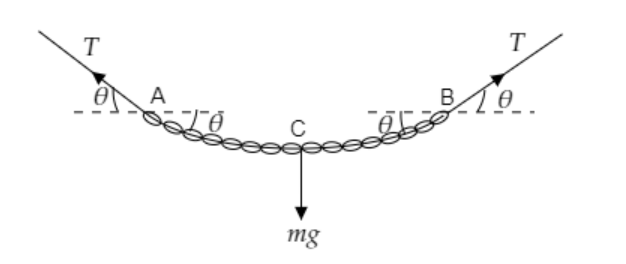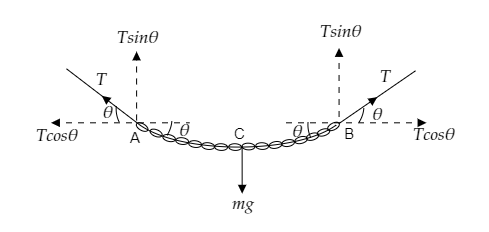Answer
64.8k+ views
Hint: In the given setup, the forces acting on the chain are the tension and the weight of the chain. Here the weight of the chain will be directed downwards. By symmetry, the tension at A and B will be equal and will be directed along the length of the chain and so will have a horizontal component and a vertical component. The force balance equation in the vertical direction will provide us with the tension at A.
Complete step by step answer:
Step 1: Sketch a free body diagram of the chain and depict the forces acting on the chain.
The above diagram represents the free body diagram of the chain.

As seen from the figure the weight of the body $W = mg$ is directed downwards at the point C. At points A and B, the tension $T$ is directed along the length of the chain making an angle $\theta $ with the horizontal.
Step 2: Resolve the tension at A and B into its horizontal component and its vertical component.

The above figure shows the resolution of the tension $T$ into its horizontal component $T\cos \theta $ and its vertical component $T\sin \theta $ .
So the forces acting in the vertical direction are the weight of the chain, the vertical components of tension at A and B.
The forces acting in the horizontal direction are the horizontal components of tension at A and B.
Step 3: Express the force balance equation in the vertical direction.
The force balance equation in the vertical direction can be expressed as
$T\sin \theta + T\sin \theta = mg$ ------------- (1)
$ \Rightarrow 2T\sin \theta = mg$
And finally, we have $T = \dfrac{{mg}}{{2\sin \theta }} = \dfrac{1}{2}mg$ $\mathrm{cosec}\theta $
So the tension at A is obtained as $T = \dfrac{1}{2}mg$ $\mathrm{cosec}\theta $
So the correct option is C.
Note: The force balance equation in the vertical direction is obtained by expressing the total forces acting on the chain i.e., $T\sin \theta + T\sin \theta - mg = 0$ . The weight has a direction opposite to that of the vertical components of the tension at A and B. We take the upward direction to be positive and so weight is negative.
Complete step by step answer:
Step 1: Sketch a free body diagram of the chain and depict the forces acting on the chain.
The above diagram represents the free body diagram of the chain.

As seen from the figure the weight of the body $W = mg$ is directed downwards at the point C. At points A and B, the tension $T$ is directed along the length of the chain making an angle $\theta $ with the horizontal.
Step 2: Resolve the tension at A and B into its horizontal component and its vertical component.

The above figure shows the resolution of the tension $T$ into its horizontal component $T\cos \theta $ and its vertical component $T\sin \theta $ .
So the forces acting in the vertical direction are the weight of the chain, the vertical components of tension at A and B.
The forces acting in the horizontal direction are the horizontal components of tension at A and B.
Step 3: Express the force balance equation in the vertical direction.
The force balance equation in the vertical direction can be expressed as
$T\sin \theta + T\sin \theta = mg$ ------------- (1)
$ \Rightarrow 2T\sin \theta = mg$
And finally, we have $T = \dfrac{{mg}}{{2\sin \theta }} = \dfrac{1}{2}mg$ $\mathrm{cosec}\theta $
So the tension at A is obtained as $T = \dfrac{1}{2}mg$ $\mathrm{cosec}\theta $
So the correct option is C.
Note: The force balance equation in the vertical direction is obtained by expressing the total forces acting on the chain i.e., $T\sin \theta + T\sin \theta - mg = 0$ . The weight has a direction opposite to that of the vertical components of the tension at A and B. We take the upward direction to be positive and so weight is negative.
Recently Updated Pages
Write a composition in approximately 450 500 words class 10 english JEE_Main

Arrange the sentences P Q R between S1 and S5 such class 10 english JEE_Main

What is the common property of the oxides CONO and class 10 chemistry JEE_Main

What happens when dilute hydrochloric acid is added class 10 chemistry JEE_Main

If four points A63B 35C4 2 and Dx3x are given in such class 10 maths JEE_Main

The area of square inscribed in a circle of diameter class 10 maths JEE_Main

Other Pages
Excluding stoppages the speed of a bus is 54 kmph and class 11 maths JEE_Main

In the ground state an element has 13 electrons in class 11 chemistry JEE_Main

Electric field due to uniformly charged sphere class 12 physics JEE_Main

A boat takes 2 hours to go 8 km and come back to a class 11 physics JEE_Main

According to classical free electron theory A There class 11 physics JEE_Main

Differentiate between homogeneous and heterogeneous class 12 chemistry JEE_Main




